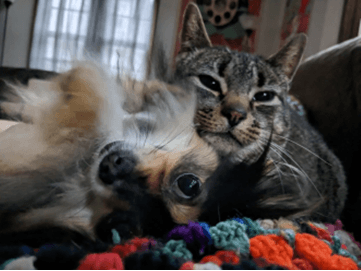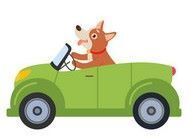
Editor’s Note: This is part three of a three-part series.
Although many people may be “team cat” or “team dog,” there are many of us who love them both equally! It’s important to ensure the safety of all our pets, and this is a special task when introducing new cats and dogs to one another.
First things first
Consider your current pet’s demeanor. If you have a dog and plan to introduce a cat, think about the following: Does your dog have any experience with cats? Does he/she chase smaller animals? Does he/she tend to be on edge versus laid-back?
If you have a cat and plan to introduce a dog, has your cat had exposure to dogs? What is their typical response to new situations?
Separate spaces
In the beginning, there must be separate spaces for each animal to feel safe and secure. Ideally, the resident pet will have mostly free roam of the home, and the new pet will be isolated to a separate place in the home. This may be a spare room, a bathroom, or an open space that has baby gates or other barriers to keep them separate and secure. The pets should remain apart at a minimum for several days. Make sure to give each pet quality time with you.
Taking it slow
If each animal seems comfortable and relaxed, the next step can begin. Each step may take only a few days, or it could take weeks. It all depends on how the animals respond.
Start with indirect exposure to one another. Swap items that carry each other’s scent. Move on to feeding each animal treats or food close to the door or barrier that separates them. Pairing the presence of the new animal with a good experience like food will create a positive association.
Disclaimer: If you have an animal who is known to guard their food, the presence of another animal near them while eating is not the best route. Perhaps a favorite toy for the dog and catnip for the cat on either side of the barrier will work to build positive associations.
If all is going well, the next step is visual introductions. This can be done by slightly opening a door so the cat and dog can see one another. Again, pair this with something positive. A treat, praise, toy, or petting are all possibilities.
Be sure to avoid scolding or punishing either animal during the process. A negative response to the other animal will only get worse if the owner pairs more negative vibes. Simply stop the interactions if anyone growls, hisses, swats, etc. Remember, growling or hissing is a good thing - they are communicating how they feel.) Revert to the previous step of the introduction process as needed.
Getting closer
Once there are consistent positive (or at least neutral) reactions to visual introductions, more direct contact can be cautiously attempted. Always keep safety a priority. Some dogs initially want to chase and pounce, which can have devastating effects (both physical and emotional) on the cat. A fearful cat who is not interested in the dog may lash out to protect itself, harming the dog and anyone in the vicinity. All direct contact should be supervised and brief in the beginning. As with all steps in the introduction process, continue to pair positive experiences with the interactions, and stop if there are negative reactions.
Over time, as they get more comfortable with one another and both animals have access to the home, it’s important to provide multiple high-rise areas of movement for cats. If a cat is fearful or chooses not to interact with the dog, running on the ground away from the dog can trigger a chase response. Do not allow the dog to chase the cat as it creates a poor habit in the dog and will contribute to the cat’s fear and discomfort of the dog. The dog should be kept on a leash or behind a gate in the beginning. If there are many vertical spaces that are cat safe, such as cat towers, shelves, cabinets, etc., the cat can avoid contact with the dog without triggering the run-and-chase sequence.
Additionally, cat’s resources should be out of reach from the dog. This includes litter boxes and feeding stations. Using the litter box and eating are times when a cat lets its guard down and can be more vulnerable to surprise interactions with the dog.
Quality time
Continue to provide plenty of intentional interactive time with each animal. If they are given adequate enrichment and outlets for their energy, this will create a more content pet. A pet who is overall content will be better equipped to handle the changes that come with a new pet.
If at any time there are concerns with safety for either animal (or for the people supervising), be sure to take a step back and re-evaluate the situation. The physical safety and stress levels of the animals should always be a priority. Patience and time are the best tools when introducing cats and dogs. It may be a long process to create harmony among the pets, and there may be times when it won’t work out. Seek guidance from professionals such as the TCHS staff whenever needed!
Rose Hegerle, CVT, is TCHS’ Director of Veterinary Services.









